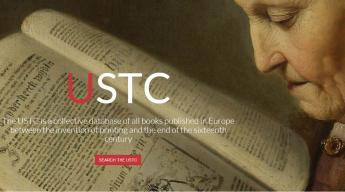Antiquarian Booksellers' Association Hinck & Wall Rare Books
The New USTC Site

By Jim Hinck
A helpful user brought to my attention the newly updated website for USTC (Universal Short Title Catalogue) which was just launched 4 days ago. For those unfamiliar with the project, its mission is to compile a ”collective database” of all European printed books from the 15th and 16th century, with a later extension into the seventeenth century also in sight. I don’t think I need to make a point of how useful this will be to anyone who does research relating to early printing.
I was able to add it to viaLibri library search without the slightest trouble. Whoever is responsible for the new design and user interface deserves great credit. As someone who uses online bibliographic databases on a regular basis and has also had to build a few myself, I have, over time, developed a lot of opinions about how these things should be done. A few minutes on the new USTC site won me over completely. If anyone is out there working on new specs for an updated bibliographic search engine I don’t think they need to look any further for their model.
One thing in particular pleased me no end. There has been a trend over the last few years to build search forms that use scroll bars instead of field labels. For example, instead of having separate fields for author, title, keyword, date, etc. you are given, instead, multiple generic fields that each require scrolling through a long list of options for selecting what that particular form field will represent. Basically, in addition to filling in the search terms, the user is also made to construct the form himself. It is a tedious process that hides all the search options from the user until he opens up the scroll bars. In many cases it is there mostly to simplify the construction of Boolean searches, but how many people actually need that? I suspect it is very few. If Boolean searches really are needed, then a separate interface should be provided, while the primary users are given an interface that is as simple and self-evident as possible.
(Posted on vialibrian. Notes for bibliophiles in a digital age. Presented here by permission of the author.)
USTC 2.0
The USTC is a collective database of all books published in Europe between the invention of printing and the end of the 16th century. The new version was launched on 11th October, 2013. “This, the product of over a year of design and developmental work by Project Manager Dr Graeme Kemp, offers a vastly improved search speed and considerable additional functionality. A striking feature is the range of new search facets displayed with the initial search results, ranking the results by author, date, place and country of publication, format and subject classification. Uniquely among major bibliographical resources, the USTC now offers a format search, a particularly valuable tool for those studying the industrial infrastructure of print and changing patterns of design and presentation.“ (Official press release)
Now the USTC provides access to over 90,000 digital editions, including more than 10,000 books. Project Director Andrew Pettegree: “The extension of the USTC’s coverage to 1650 will more than double the size of the database, and even before that we propose to display many thousands of additional copies of German and Italian books not listed in the respective national bibliographies. The fact that we are also able to present our data in a way that will make possible a whole new raft of analytical searches should also be a major service to users.”
The development of the USTC will continue with the following features:
• 10,000 new digital links for books published in France
• 2,000 new edicts and broadsheets printed in Bologna
• copies and editions of sixteenth-century Italian books in French libraries
• 1,000 new German broadsheets
• Locations of Luther’s works in libraries outside Germany
For more information visit the official USTC website and its news blog.
